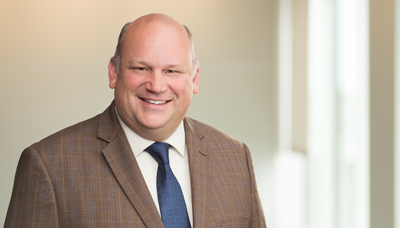Greg Cooper, a patent attorney in Barnes & Thornburg LLP's Fort Wayne, Indiana office and a member of the firm's Intellectual Property Law Department, authored the column, "Earthmovers' blades adjust to tilted ground," for the May 30, 2011 edition of the Fort Wayne Journal-Gazette. Greg's column, "Patently Speaking," highlights various patents issued by the U.S. Patent and Trademark Office.
Greg is an attorney in Fort Wayne practicing in the areas of patent, trademark, copyright, procurement, and litigation in the U.S. and internationally. He can be reached at gcooper@btlaw.com or (260)425-4660.
A copy of Greg's article for the week of May 30, 2011 appears below.
PATENTLY SPEAKING
May 30, 2011
Patently Speaking highlights the technological achievements of Fort Wayne area residents.
SYSTEM AND METHOD FOR BLADE LEVEL CONTROL OF EARTHMOVING MACHINES
U.S. Patent No. 7,942,208
Invented by: Edward C. Hughes, IV, Fort Wayne, IN; Christopher Alan Williamson, West Lafayette, IN; Joshua D. Zimmerman, Lafayette, IN; and Monika Marianne Ivantysynova, Lafayette, IN
Assigned to: Purdue Research Foundation, West Lafayette, IN
Compact excavating machines include both a backhoe function to scoop out dirt and a bulldozer blade to push that dirt around. After a hole is dug, the blade pushes the dirt to another location or backfills the hole like a bulldozer.
Backhoes and bulldozers are well known and have been used for years. While moving dirt these machines often operate on unlevel ground angles. These conditions present a challenge when using the blade portion of the compact excavator. This is because the blade is parallel to the excavator and a level ground surface. This means the excavator and blade sit at an angle. Backfilling under this circumstance now becomes difficult. The blade needs to be at a different angle than the excavator.
This patent describes a hydraulic system that can raise and lower the blade independent from the angled position of the excavator. The system includes a fluid actuator and an electronic control system. The absolute orientation of the excavator is read by the controller which calculates the amount of pressurized fluid needed to change the angle of the blade. The fluid actuator then energizes enough to change the blade angle.
SELF-CONTAINED WIRELESS CAMERA DEVICE, WIRELESS CAMERA SYSTEM AND METHOD
U.S. Patent No. 7,944,484
Invented by Robert Kniskem, Fort Wayne, IN; Peter Strandwitz, Neenah, WI; Gary D. Schulz, Cary, IL; and Jan-Michael Wyckoff, Schaumburg, IL
Assigned to: MemoryLink Corporation (Neenah, WI)
This patent’s original disclosure was filed back in 1998 and describes a wireless camera system.
Though not the first wireless camera technology, this patent describes using a system based on the 5 GHz bandwidth to transmit and receive signals. This allows the camera to transmit more video or picture data without exhausting all the bandwidth. It even allows multiple cameras to operate on the same network.
The preceding are lay descriptions of patents obtained from the United States Patent and Trademark Office’s public records and are provided for general information purposes only. Nothing contained herein is a legal description of any claimed invention, identification of novelty, or offer of legal advice. Because issued patents are based on applications often filed years earlier, the subject matter of some patents may have been available on the market for some time prior to the issuance of the patent. Additional information on these patents is available at www.uspto.gov.














